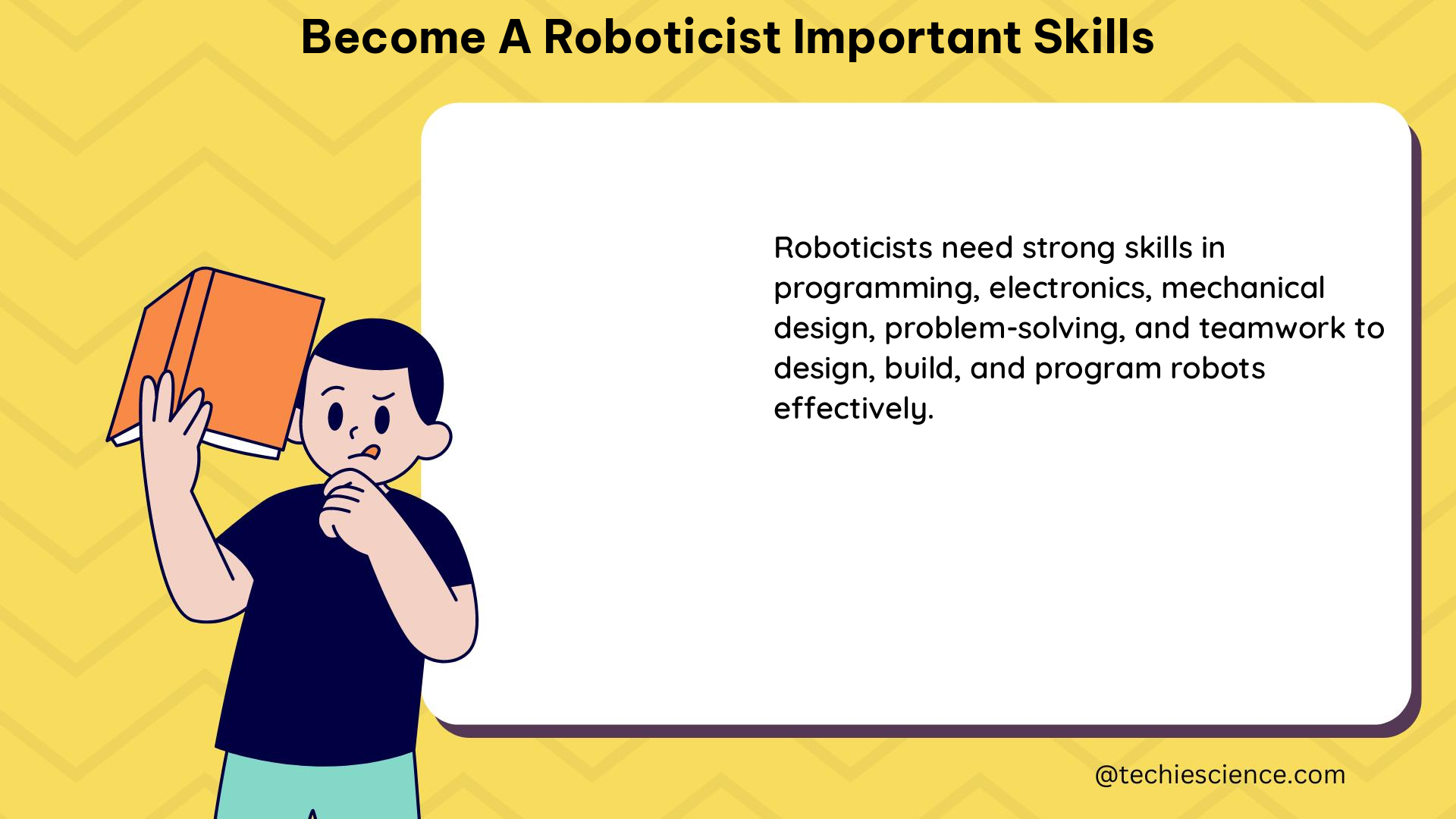As a roboticist, you’ll be responsible for designing, developing, and maintaining complex robotic systems that can perform a wide range of tasks. To excel in this field, you’ll need to possess a unique blend of technical and non-technical skills. In this comprehensive guide, we’ll delve into the essential skills required to become a successful roboticist, providing you with a detailed roadmap to help you achieve your goals.
Technical Skills
1. Programming Expertise
Robotics is heavily dependent on software, and as a roboticist, you’ll need to have a strong foundation in programming languages such as C++, Python, and Java. These languages are widely used in the development of robotic control systems, sensor integration, and data processing. Additionally, you should be familiar with software development tools like the Robot Operating System (ROS) and MATLAB, which are commonly used in the robotics industry.
Key Programming Concepts:
– Object-Oriented Programming (OOP) principles
– Data structures and algorithms
– Real-time programming and concurrency
– Embedded systems programming
– Sensor and actuator control
Programming Language Proficiency:
– C++: Mastery of the language’s syntax, memory management, and object-oriented features. Understanding of the Standard Template Library (STL) and its use in robotics applications.
– Python: Expertise in Python’s syntax, data structures, and libraries like NumPy, SciPy, and Matplotlib, which are widely used in robotics for data analysis and visualization.
– Java: Familiarity with Java’s object-oriented design, concurrency, and the use of libraries like ROS Java and OpenCV Java for robotics development.
2. Mechanical Engineering Skills
Robotics is a multidisciplinary field, and as a roboticist, you’ll need to have a solid understanding of mechanical engineering principles. This includes knowledge of kinematics, dynamics, and control systems, which are essential for designing and analyzing the physical components of a robotic system.
Mechanical Engineering Concepts:
– Kinematics: Forward and inverse kinematics, Denavit-Hartenberg (DH) parameters, and Jacobian matrices.
– Dynamics: Lagrangian and Newtonian formulations, rigid body dynamics, and control system design.
– Control Systems: PID control, state-space representation, and optimal control techniques.
CAD Software Proficiency:
– SolidWorks: Expertise in 3D modeling, assembly design, and simulation for robotic systems.
– AutoCAD: Proficiency in 2D drafting and design for mechanical components and assemblies.
3. Electrical Engineering Skills
Robotics also requires a strong understanding of electrical engineering principles, including circuit design, power electronics, and control systems. As a roboticist, you’ll need to be able to design and integrate the electrical and electronic components of a robotic system, such as sensors, actuators, and microcontrollers.
Electrical Engineering Concepts:
– Circuit Design: Analog and digital circuit design, including op-amps, filters, and power supplies.
– Power Electronics: Motor control, power conversion, and energy storage systems.
– Control Systems: Feedback control, state-space representation, and digital control techniques.
Electrical Design Software Proficiency:
– Altium: Expertise in schematic capture, PCB design, and simulation for robotic electronics.
– Eagle: Proficiency in PCB design and layout for smaller-scale robotic projects.
4. Robotics System Integration
Robotics is not just about designing individual components; it’s also about integrating these components into a cohesive and functional system. As a roboticist, you’ll need to have experience in integrating various subsystems, such as sensors, actuators, and controllers, into a complete robotic system.
System Integration Concepts:
– Sensor Fusion: Combining data from multiple sensors to improve the accuracy and reliability of a robotic system.
– Actuator Control: Designing and implementing control algorithms for various types of actuators, such as motors, hydraulics, and pneumatics.
– Real-Time Control: Developing and implementing real-time control systems for robotic applications, including task scheduling and resource management.
System Integration Tools:
– ROS (Robot Operating System): Proficiency in using ROS for integrating robotic subsystems, including sensor and actuator interfaces, as well as high-level control and planning.
– MATLAB/Simulink: Expertise in using MATLAB and Simulink for modeling, simulation, and rapid prototyping of robotic systems.
5. Mathematics and Science Foundations
Robotics is a highly technical field that requires a strong foundation in various branches of mathematics and science. As a roboticist, you’ll need to have a solid understanding of concepts such as algebra, calculus, geometry, physics, and applied mathematics.
Mathematical Concepts:
– Linear Algebra: Matrices, vectors, and transformations for kinematics and control.
– Calculus: Differentiation and integration for modeling dynamics and control systems.
– Geometry: Coordinate systems, transformations, and spatial reasoning for robot navigation and manipulation.
Scientific Concepts:
– Physics: Mechanics (statics, dynamics, and kinematics), electromagnetism, and thermodynamics.
– Applied Mathematics: Optimization, probability, and statistics for data analysis and decision-making.
Non-Technical Skills

1. Judgment and Decision-Making
As a roboticist, you’ll often be faced with complex engineering problems that require sound judgment and decision-making skills. You’ll need to be able to weigh the pros and cons of different solutions, analyze the trade-offs, and make informed decisions that balance technical, economic, and ethical considerations.
Key Judgment and Decision-Making Skills:
– Critical Thinking: Ability to analyze problems, identify key issues, and evaluate alternative solutions.
– Problem-Solving: Skill in breaking down complex problems, generating creative solutions, and implementing effective strategies.
– Risk Assessment: Capacity to identify and mitigate potential risks associated with robotic systems.
2. Communication Skills
Robotics is a multidisciplinary field, and as a roboticist, you’ll need to be able to effectively communicate with a wide range of stakeholders, including engineers, scientists, managers, and end-users. Strong communication skills will help you explain technical concepts, present your ideas, and collaborate with team members.
Communication Competencies:
– Verbal Communication: Ability to clearly and concisely explain technical concepts to both technical and non-technical audiences.
– Written Communication: Skill in producing well-structured technical reports, proposals, and documentation.
– Presentation Skills: Capacity to deliver engaging and informative presentations to various stakeholders.
3. Technology Design
Roboticists must be proficient in the design of technological systems that not only work but also address the specific needs and requirements of their users. This involves understanding the problem domain, identifying the key design constraints, and developing innovative solutions that balance technical feasibility, user experience, and cost-effectiveness.
Technology Design Competencies:
– User-Centered Design: Ability to empathize with end-users, understand their needs, and design robotic systems that meet their requirements.
– Prototyping and Iteration: Skill in rapidly building and testing prototypes to validate design concepts and gather feedback.
– Design Optimization: Capacity to optimize the design of robotic systems for factors such as performance, reliability, and cost.
4. Systems Thinking
Robotics is a complex field that involves the integration of various subsystems, including mechanical, electrical, and software components. As a roboticist, you’ll need to have a strong understanding of how these different systems work together and how they can be optimized to achieve the desired outcomes.
Systems Thinking Competencies:
– Holistic Understanding: Ability to comprehend the interconnected nature of robotic systems and how changes in one component can affect the overall performance.
– Troubleshooting: Skill in identifying and resolving issues within complex robotic systems by analyzing the interactions between different subsystems.
– Optimization: Capacity to optimize the performance of robotic systems by adjusting the parameters and configurations of various components.
5. Active Learning
The field of robotics is constantly evolving, with new technologies, algorithms, and applications emerging at a rapid pace. As a roboticist, you’ll need to be an active learner, constantly seeking out new knowledge and skills to stay ahead of the curve.
Active Learning Competencies:
– Curiosity and Adaptability: Ability to embrace new challenges, explore unfamiliar domains, and quickly adapt to changing technologies and requirements.
– Self-Directed Learning: Skill in identifying knowledge gaps, seeking out relevant resources, and continuously expanding your expertise.
– Lifelong Learning: Commitment to ongoing professional development and a willingness to learn from both successes and failures.
By mastering these technical and non-technical skills, you’ll be well-equipped to navigate the dynamic and exciting world of robotics, contributing to the development of innovative solutions that can transform industries and improve people’s lives.
Measuring the Value of Robotics Projects
To assess the success and impact of robotics projects, it’s essential to focus on key metrics that align with the client’s objectives. Some of the critical metrics to consider include:
- Cost Savings: Evaluate the financial benefits of implementing robotic solutions, such as reduced labor costs, improved efficiency, and increased productivity.
- Effectiveness: Measure the performance and reliability of the robotic system in achieving the desired outcomes, such as improved quality, increased throughput, or enhanced safety.
- Innovation: Assess the degree of technological innovation and the potential for the robotic solution to disrupt existing processes or create new opportunities.
- Satisfaction: Gauge the level of satisfaction among end-users and stakeholders with the robotic system’s usability, user experience, and overall impact on their operations.
Data analysis is a crucial step in assessing the success of a robot’s adoption and understanding its impact. By collecting, processing, and interpreting relevant data, you can gain insights into various aspects of the robot’s performance, such as:
- Operational Metrics: Uptime, cycle time, throughput, and error rates.
- Maintenance Metrics: Downtime, repair frequency, and spare parts consumption.
- Safety Metrics: Incident rates, near-misses, and worker injuries.
- User Feedback: Satisfaction surveys, usage patterns, and reported issues.
By leveraging these data-driven insights, you can continuously optimize the robotic system, address any challenges, and demonstrate the tangible value it brings to the client.
DIY Robotics Projects
For individuals interested in exploring robotics as a hobby or a learning opportunity, there are several resources and platforms available for DIY (Do-It-Yourself) projects. These can be excellent ways to develop your technical skills and gain hands-on experience in robotics.
One of the most popular open-source frameworks for robotics is the Robot Operating System (ROS). ROS provides a set of software libraries and tools that can be used to build robotic applications. It supports a wide range of hardware platforms, sensors, and actuators, making it a versatile choice for DIY projects.
Another popular platform for DIY robotics is the Arduino, a microcontroller board that can be programmed to control various electronic components, including motors, sensors, and actuators. Arduino is known for its simplicity, affordability, and extensive community support, making it an excellent choice for beginners.
The Raspberry Pi, a single-board computer, is another popular platform for DIY robotics. With its powerful processing capabilities, GPIO (General-Purpose Input/Output) pins, and support for various programming languages, the Raspberry Pi can be used to build a wide range of robotic projects, from simple line-following robots to more complex autonomous systems.
By engaging in DIY robotics projects, you can not only develop your technical skills but also foster your creativity, problem-solving abilities, and passion for the field of robotics.
References
- Robotics Skills: What You Need to Become a Roboticist
- How Do You Measure the Value of Robotics Projects for Clients?
- 10 Essential Skills That All Good Roboticists Have
- Robotics Engineer Resume Examples
- Robotics skills: What are the key skills required for a career in robotics?

I have a background in Aerospace Engineering, currently working towards the application of Robotics in the Defense and the Space Science Industry. I am a continuous learner and my passion for creative arts keeps me inclined towards designing novel engineering concepts.
With robots substituting almost all human actions in the future, I like to bring to my readers the foundational aspects of the subject in an easy yet informative manner. I also like to keep updated with the advancements in the aerospace industry simultaneously.